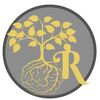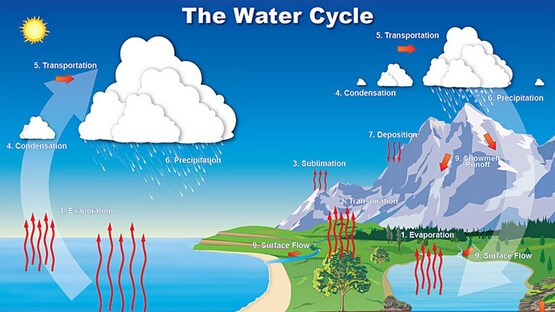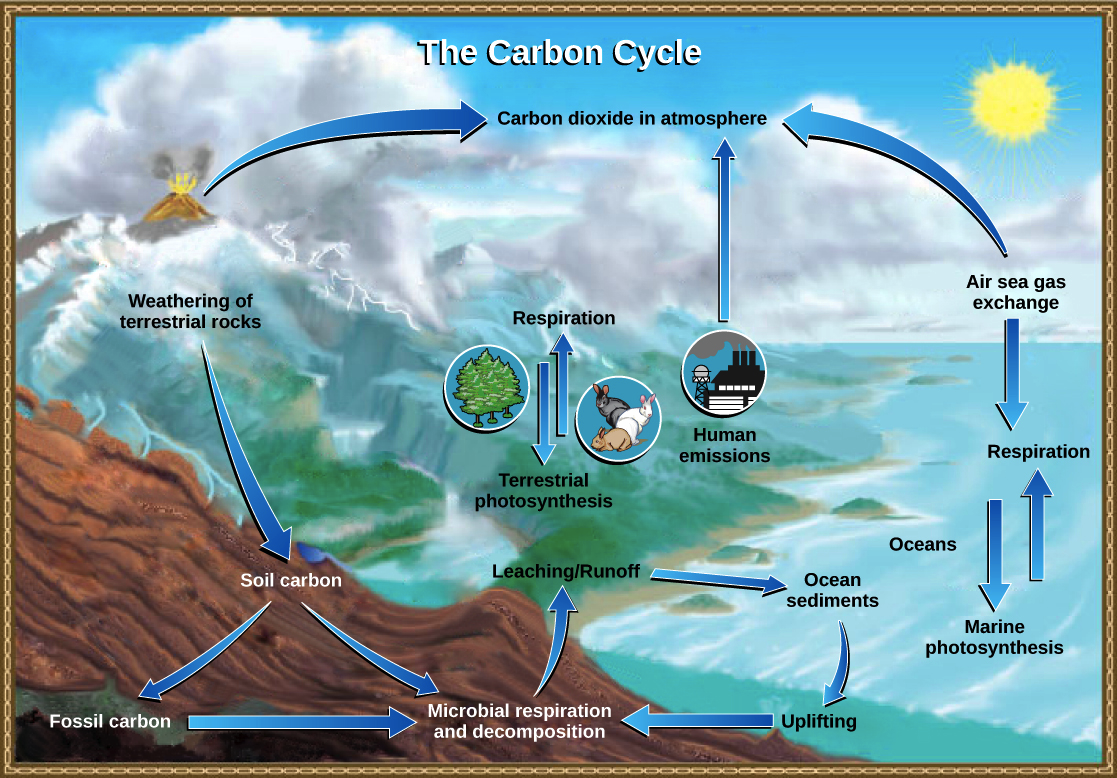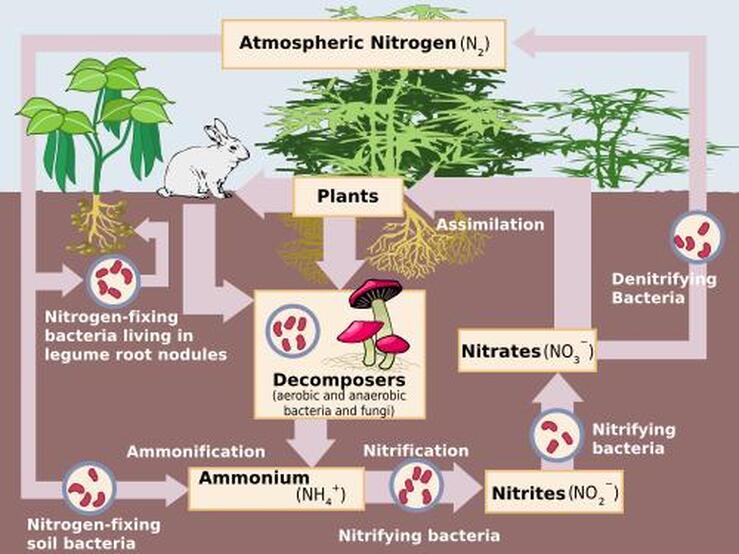On this page we explore some of the function that emerges from the patterns expressed within natural ecosystems. These patterns are those of surface area (zonation), height (stratification) and time (succession) and the complexity of interactions within species that results in matter being recycled and energy more efficient used - so that those ecosystems evolve into complex and stable states that utilise available matter and energy resources more effectively.
Understanding ecosystems is a good place to start with the design of healthy farm systems that will provide a sustainable supply of resources. A healthy farm functions in a similar way to a natural ecosystem with complex interactions between the plants and animals that are on that farm. The main difference is we substitute the natural species with those that have agricultural use or support agricultural production.
The challenge our civilization faces is to learn new ways of meeting our demand for resources in ways that tie in with what ecosystems can sustainably provide. Humanity has the amazing capacity to learn creative new solutions to problems we face and permaculture provides us with a thinking system to apply these creative solutions to providing our resources in a way that will regenerate the land.
An ecosystem is a distinct habitat with a range of organisms (plants and animals) adapted to that habitat. The plants and animal that share that habitat are engaged in a complex series of interactions where they compete for resources, prey upon each other and modify the habitat in ways that affect the other living things that share that habitat.
Ecosystems with higher biodiversity tend to be more stable with greater resistance and resilience in the face of disturbances, disruptive events.
Because ecosystems components are interdependent, by degrading or improving one aspect of ecosystem health, the entire system can likewise be degraded or improved. Rebuilding soil organic matter pumps carbon dioxide into the soil in the form of soil carbon and creates an upward spiral of ecosystem health. Making soil health a central goal of agricultural policies worldwide will be essential for achieving global food and water security and mitigating climate change. The benefits of a switch to a more ecologically oriented farming system would be seen in human and animal health, and improvements in soil and water quality.
An ecosystem includes all of the biotic factors or living things (plants, animals and organisms) in a given area, interacting with each other, and also with their non-living environments (weather, earth, sun, soil, climate, and atmosphere). The non-living aspects of an ecosystem are called abiotic factors. At a basic functional level, ecosystem generally contains primary producers (plants) capable of harvesting energy from the sun through the process called photosynthesis. This energy then flows through the food chain. Next come consumers. Consumers could be primary consumers (herbivores) or secondary consumers (carnivores). These consumers feed on the captured energy.
The flow of energy through food webs, the recycling of matter within Earth's spheres and underlying these complexities the underlying strand of how ecological systems organise themselves in a balanced complexity to most efficient use of available resources in a way that stabilises those resources and supports the continuation of life. It is with these structures in mind that we need to design our own structures to arrive at the same resilient productivity.
Understanding ecosystems is a good place to start with the design of healthy farm systems that will provide a sustainable supply of resources. A healthy farm functions in a similar way to a natural ecosystem with complex interactions between the plants and animals that are on that farm. The main difference is we substitute the natural species with those that have agricultural use or support agricultural production.
The challenge our civilization faces is to learn new ways of meeting our demand for resources in ways that tie in with what ecosystems can sustainably provide. Humanity has the amazing capacity to learn creative new solutions to problems we face and permaculture provides us with a thinking system to apply these creative solutions to providing our resources in a way that will regenerate the land.
An ecosystem is a distinct habitat with a range of organisms (plants and animals) adapted to that habitat. The plants and animal that share that habitat are engaged in a complex series of interactions where they compete for resources, prey upon each other and modify the habitat in ways that affect the other living things that share that habitat.
Ecosystems with higher biodiversity tend to be more stable with greater resistance and resilience in the face of disturbances, disruptive events.
Because ecosystems components are interdependent, by degrading or improving one aspect of ecosystem health, the entire system can likewise be degraded or improved. Rebuilding soil organic matter pumps carbon dioxide into the soil in the form of soil carbon and creates an upward spiral of ecosystem health. Making soil health a central goal of agricultural policies worldwide will be essential for achieving global food and water security and mitigating climate change. The benefits of a switch to a more ecologically oriented farming system would be seen in human and animal health, and improvements in soil and water quality.
An ecosystem includes all of the biotic factors or living things (plants, animals and organisms) in a given area, interacting with each other, and also with their non-living environments (weather, earth, sun, soil, climate, and atmosphere). The non-living aspects of an ecosystem are called abiotic factors. At a basic functional level, ecosystem generally contains primary producers (plants) capable of harvesting energy from the sun through the process called photosynthesis. This energy then flows through the food chain. Next come consumers. Consumers could be primary consumers (herbivores) or secondary consumers (carnivores). These consumers feed on the captured energy.
The flow of energy through food webs, the recycling of matter within Earth's spheres and underlying these complexities the underlying strand of how ecological systems organise themselves in a balanced complexity to most efficient use of available resources in a way that stabilises those resources and supports the continuation of life. It is with these structures in mind that we need to design our own structures to arrive at the same resilient productivity.
|
|
|
Ecosystem Patterns
| introduction_to_succession.pdf |
There are three main ecological patterns of interest in permaculture design: stratification, zonation and succession. We will explore these patterns in greater detail when they are applied within different context of permaculture design. Here we will outline the intend within ecology of organising biological systems with these patterns.
Stratification = The layering of living things within an ecosystem, such as the layers of plants within a forest (ground cover, shrubs, small trees, large trees, vines etc). This is a way ecologist divide organisms into different groups based on their organisation by height within a shared ecosystem.In a similar way we can design food forests with a multi-layered canopy. This allows us to capture lights at multiple layers and use that larger catchment to be able to create for products of photosynthesis (berries, nuts, fruit, herbs etc).
Zonation = A way or categorizing living things within an ecosystem by dividing them on the basis of distance from an edge between two systems. For example as you go deeper into the forest from the edge there will be different communities of plants adapted to being at the edge of the forest or deep within it. Another example is a rocky shore where biological communities will be different depending upon how close to the shore they are and expose during high / low tides.
Succession = Changes in biological communities over time. When an ecosystem is disturbed by some natural or man made event there is a predictable succession or change in biological communities that will occupy a site and impact that site in ways that will change what communities live there. This dynamic changes in communities over time result in an increasing complexity and diversity of species, resulting in the changes slowing down and becoming more stable over time. Until the next disturbance puts it into a state of flux and change. In permaculture designs we make use of our knowledge of the changes in management of weeds, predict changes in plant communities and as a management with grazers to maintain a system at a point of succession.
Stratification = The layering of living things within an ecosystem, such as the layers of plants within a forest (ground cover, shrubs, small trees, large trees, vines etc). This is a way ecologist divide organisms into different groups based on their organisation by height within a shared ecosystem.In a similar way we can design food forests with a multi-layered canopy. This allows us to capture lights at multiple layers and use that larger catchment to be able to create for products of photosynthesis (berries, nuts, fruit, herbs etc).
Zonation = A way or categorizing living things within an ecosystem by dividing them on the basis of distance from an edge between two systems. For example as you go deeper into the forest from the edge there will be different communities of plants adapted to being at the edge of the forest or deep within it. Another example is a rocky shore where biological communities will be different depending upon how close to the shore they are and expose during high / low tides.
Succession = Changes in biological communities over time. When an ecosystem is disturbed by some natural or man made event there is a predictable succession or change in biological communities that will occupy a site and impact that site in ways that will change what communities live there. This dynamic changes in communities over time result in an increasing complexity and diversity of species, resulting in the changes slowing down and becoming more stable over time. Until the next disturbance puts it into a state of flux and change. In permaculture designs we make use of our knowledge of the changes in management of weeds, predict changes in plant communities and as a management with grazers to maintain a system at a point of succession.
Energy Flow
The energy that flow through ecosystems originates from the Sun in most of the world's ecosystems.
This energy is transformed into biological molecules by plants, algae and bacteria by the biological process called photosynthesis. Once converted to fats, sugars, and proteins by plants it is then available as food to sustain a complex food web of life within the world's ecosystems.
Energy flows through an ecosystem in only one direction. Energy is passed from organisms at one trophic level or energy level to organisms in the next trophic level. Producers are always the first trophic level, herbivores the second, the carnivores that eat herbivores the third, and so on.
Most of the energy at a trophic level – about 90% – is used at that trophic level. Organisms need it for growth, locomotion, heating themselves, and reproduction. So animals at the second trophic level have only about 10% as much energy available to them as do organisms at the first trophic level. Animals at the third level have only 10% as much available to them as those at the second level.
The set of organisms that pass energy from one trophic level to the next is described as the food chain (Figure below). In this simple depiction, all organisms eat at only one trophic level. There are generally only four to five levels within a food chain due to there being not enough energy from the producers to support further levels of consumers.
To maximise the use of energy within a food web, nature has maximised the diversity and complexity of ecosystems, which has resulted in each species having to find specialised niches to survive in the face of this competition.
This energy is transformed into biological molecules by plants, algae and bacteria by the biological process called photosynthesis. Once converted to fats, sugars, and proteins by plants it is then available as food to sustain a complex food web of life within the world's ecosystems.
Energy flows through an ecosystem in only one direction. Energy is passed from organisms at one trophic level or energy level to organisms in the next trophic level. Producers are always the first trophic level, herbivores the second, the carnivores that eat herbivores the third, and so on.
Most of the energy at a trophic level – about 90% – is used at that trophic level. Organisms need it for growth, locomotion, heating themselves, and reproduction. So animals at the second trophic level have only about 10% as much energy available to them as do organisms at the first trophic level. Animals at the third level have only 10% as much available to them as those at the second level.
The set of organisms that pass energy from one trophic level to the next is described as the food chain (Figure below). In this simple depiction, all organisms eat at only one trophic level. There are generally only four to five levels within a food chain due to there being not enough energy from the producers to support further levels of consumers.
To maximise the use of energy within a food web, nature has maximised the diversity and complexity of ecosystems, which has resulted in each species having to find specialised niches to survive in the face of this competition.
Recycling Matter
Matter is recycled continuously within biological systems which act to moderate the availability of these substances in a way that supports the continued presence of life. In this way biological systems are able to terra-form their planets and bring it to a state of stability that supports further life.
We are part of this matrix of life and like the rest of it we need to align our functions to those that support and preserve life. The work of the permaculture designer is to create abundant systems that flow with the processes of life and work in with the recycling of materials to support.
Carbon Cycle
Water Cycle
Nitrogen Cycle.
We are part of this matrix of life and like the rest of it we need to align our functions to those that support and preserve life. The work of the permaculture designer is to create abundant systems that flow with the processes of life and work in with the recycling of materials to support.
Carbon Cycle
- The carbon cycle describes the movement of carbon between the different spheres of Earth. Carbon is present in the atmosphere as carbon dioxide gas, within the soil as organic matter, and within living things in the biological molecules that compose their bodies. The movement of carbon between these spheres ensures the fertility and abundance of biological systems. At the base of terrestrial systems is a thriving soil ecology and the addition of fresh sources of carbon to this system acts as a crucial part of maintaining and building its fertility.
- The addition of sources of carbon back to soil must therefore be of primary importance in developing a sustainable agricultural system.
Water Cycle
- The water cycle is a process that allows water to be available in continuously fresh forms to be drawn into biological systems and support the function of life.
- Living systems have evolved in the context of aquatic systems and water provides an environment for all life processes.
- The water cycle describes the movement of water between the different spheres of the Earth. This is illustrated in the diagram below.
Nitrogen Cycle.
- Nitrogen is an important component of DNA and proteins and therefore an important nutrient for the growth of biological organisms. The atmosphere is rich in Nitrogen, with 70% of air composed of it, but its availability in soil is a major limiting factor to support plant growth.
- Atmospheric Nitrogen is converted to water soluble nitrates by soil bacteria that exchange these nitrates with plants for sugars. Because the nitrates are water soluble plants are able to draw them through their root system and combine them with other molecules to make proteins and DNA.
- Once Nitrogen is captures by plants it then becomes available for the rest of the food web within an ecosystems as consumers eat them.
- Excess nitrates can also cause environmental problems when excessive fertilizers or numbers of animals are present within agricultural systems.




